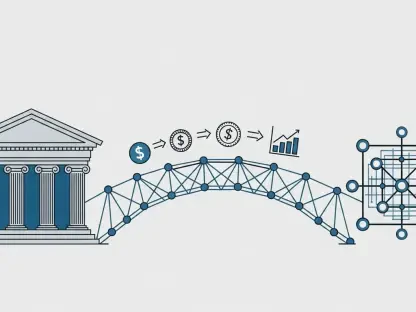In the heart of Frankfurt, the Sibos 2025 conference has emerged as a landmark event, drawing the sharpest minds in global finance to dissect the transformative power of emerging technologies and explore their impact on the industry. Leaders from Swift, Deutsche Bundesbank, and Deutsche Bank have converged to discuss how artificial intelligence (AI), quantum computing, and central bank digital currencies (CBDCs) are not just buzzwords but critical tools reshaping the financial ecosystem. Far from a theoretical exercise, this gathering delves into the practical implications of these innovations, addressing how they can enhance efficiency, streamline cross-border transactions, and strengthen security. The urgency to adapt is palpable, as consumer demand for faster, more flexible payment systems clashes with the need to maintain stability in an increasingly complex world. This event serves as a crucible for ideas, where collaboration and caution intertwine to chart the future of finance amid geopolitical tensions and regulatory challenges.
Exploring the New Financial Horizon
The central theme at Sibos 2025 revolves around navigating the next era of global finance, where technological advancements must be harnessed with precision to avoid destabilizing the industry. Graeme Munro, chair of Swift, emphasized that financial institutions can no longer operate in silos if they hope to keep pace with rapid innovation. His call for continuous improvement through collaboration underscores a fundamental shift: transactional banking must be fortified with shared expertise to ensure robust security frameworks. Beyond mere adaptation, this approach aims to preempt vulnerabilities that could arise from unchecked technological integration. The stakes are high, as the financial sector grapples with balancing consumer expectations against the imperative of compliance. Munro’s vision sets a tone of urgency, suggesting that only through collective effort can the industry build a resilient foundation capable of supporting the next wave of digital transformation.
Javier Pérez-Tasso, CEO of Swift, added depth to this narrative by pinpointing specific technologies driving change, including AI, quantum computing, and blockchain solutions. He highlighted the escalating demand for instant cross-border payments, a trend reflecting consumer impatience with traditional delays. A groundbreaking announcement came with Swift’s plan to integrate a blockchain-based ledger into its infrastructure, designed to facilitate seamless movement of tokenized value across digital platforms. This initiative, developed in collaboration with over 30 global banks, seeks to bridge the gap between traditional finance and decentralized systems, provided regulation keeps pace. Pérez-Tasso’s optimism about this coexistence challenges skeptics, positing that harmonized systems could redefine how value is transferred globally. This bold step underscores a broader industry pivot toward embracing digital tools while ensuring they align with established norms.
Central Banks Charting a Digital Course
From a central banker’s perspective, Joachim Nagel, president of Deutsche Bundesbank, articulated a vision for a “truly smart economy” fueled by digital money, smart contracts, and automated settlements. His advocacy for these technologies comes with a critical caveat: innovation must serve a purpose beyond novelty. Financial stability and effective monetary policy remain non-negotiable, even as digital solutions promise to revolutionize transactions. Nagel’s focus on the digital euro, expected to launch within the next four years, positions it as a pivotal tool for enhancing Europe’s digital infrastructure. This initiative isn’t just about modernizing payments; it’s a strategic move to bolster global financial sovereignty in an era of increasing digital competition. His cautious optimism reflects a broader concern among central banks to integrate cutting-edge tools without compromising the systemic safeguards that underpin economic trust.
Nagel’s framework for progress rests on three core principles: maintaining stability, avoiding market distortions, and ensuring compliance with existing regulations. This structured approach aims to temper the rush toward digital transformation with a clear-eyed assessment of potential risks. For instance, while distributed ledger technology offers unprecedented efficiency in settlements, it also introduces complexities in oversight that could destabilize markets if mishandled. The digital euro, in this context, emerges as a test case for balancing innovation with control, potentially setting a precedent for other CBDCs worldwide. Nagel’s emphasis on purposeful advancement serves as a reminder that technology must solve real problems rather than create new ones. His perspective underscores the delicate dance central banks must perform as they navigate uncharted digital waters while safeguarding the broader financial ecosystem against volatility.
Confronting a Shifting Global Landscape
Christian Sewing, CEO of Deutsche Bank, broadened the discussion by addressing the multifaceted challenges confronting the financial sector in a turbulent world. Geopolitical tensions have shifted global trade dynamics, replacing cooperation with confrontation, and casting a shadow over traditional finance models. Sewing redefined the role of banks as not just financial intermediaries but as critical infrastructure providers, risk managers, and technology investors in a hyper-connected economy. This redefinition acknowledges the profound impact of AI and other disruptive forces, even as their full implications remain uncertain. His analysis points to a sector at a crossroads, where adapting to external pressures—be they political or technological—demands a fundamental rethinking of how banks operate within the global marketplace.
Beyond geopolitics, Sewing identified additional hurdles such as regulatory fragmentation, intensifying competition, and declining customer loyalty fueled by agile fintech rivals. These pressures threaten to erode the traditional dominance of established institutions unless they innovate swiftly. To counter this, he urged deeper collaboration between financial entities and tech firms, particularly in areas like transaction banking, security, and sustainable initiatives. Such partnerships could help standardize practices across fragmented regulatory environments while addressing consumer demands for seamless, tech-driven services. Sewing’s call to action highlights a stark reality: banks must evolve into hybrid entities that blend financial expertise with technological prowess. This shift is essential not only for survival but for maintaining relevance in an industry increasingly defined by speed and adaptability.
Harmonizing Innovation with Systemic Safety
A recurring theme among the speakers at Sibos 2025 is the critical need to balance the promise of new technologies with the imperative of systemic stability. AI, quantum computing, CBDCs, tokenized assets, and stablecoins hold immense potential to streamline payments and boost operational efficiency across the board. Yet, there’s a palpable concern about risks such as market volatility or regulatory gaps that could undermine these advancements if not addressed proactively. Speakers consistently stressed that embracing innovation without robust governance frameworks might expose the financial system to unintended consequences. This cautious approach reflects a mature understanding that while technology can solve many problems, it can also amplify existing vulnerabilities if deployed without careful oversight.
The consensus on stability extends to the practical rollout of digital solutions, where consumer-driven demand for faster, more flexible financial services must be met with stringent safeguards. For instance, while instant cross-border payments address a clear market need, they also raise questions about security and compliance that remain unresolved. The integration of blockchain-based systems, as proposed by Swift, further complicates this landscape by introducing decentralized elements into traditionally centralized structures. Ensuring these innovations do not weaken monetary policy or destabilize markets requires a delicate calibration of technology and regulation. This balance is not merely a technical challenge but a philosophical one, demanding that the industry prioritize long-term resilience over short-term gains.
Building the Future Through Collaboration
Collaboration emerged as a cornerstone for addressing the complex challenges facing global finance, with every speaker at Sibos 2025 echoing its necessity. Swift’s blockchain ledger project, developed alongside numerous global banks, exemplifies how collective input can shape solutions that benefit the entire industry. This initiative aims to create a standardized platform for tokenized value transfer, potentially setting a benchmark for integrating decentralized finance within regulated frameworks. Such cooperative efforts are seen as vital for overcoming obstacles like fragmented regulatory landscapes, which vary widely across regions and hinder seamless innovation. The shared commitment to collaboration signals a shift toward a more interconnected financial ecosystem where mutual goals take precedence.
Equally important is the push for partnerships between traditional institutions, central banks, and fintech innovators, as highlighted by both Nagel and Sewing. These alliances are crucial for aligning technological advancements with regulatory expectations, ensuring that security and compliance remain paramount. For instance, fintechs bring agility and fresh perspectives that can accelerate the adoption of AI or CBDCs, while established entities offer the scale and stability needed to implement these changes responsibly. This synergy is not just about sharing resources but about fostering a culture of trust and shared purpose. As the financial landscape continues to evolve, such collaborative models will likely define the industry’s ability to tackle emerging challenges while driving sustainable growth on a global scale.
Reflecting on a Transformative Dialogue
Looking back on the discussions at the Sibos conference in Frankfurt, it’s evident that a pivotal dialogue unfolded, uniting diverse perspectives on the trajectory of global finance. Industry leaders from Swift, Deutsche Bundesbank, and Deutsche Bank laid out a roadmap where AI, quantum computing, and CBDCs stood as pillars of transformation, tempered by a steadfast commitment to stability. Their insights painted a picture of an industry poised for reinvention, yet acutely aware of the risks tied to rapid change. Moving forward, the emphasis must remain on actionable collaboration, with initiatives like the digital euro and blockchain ledgers serving as testbeds for innovation within regulated bounds. Financial institutions are encouraged to deepen partnerships with fintechs and regulators to standardize practices and enhance security. As the sector navigates geopolitical and competitive headwinds, this collective spirit will be the bedrock for building a resilient, tech-driven future.









